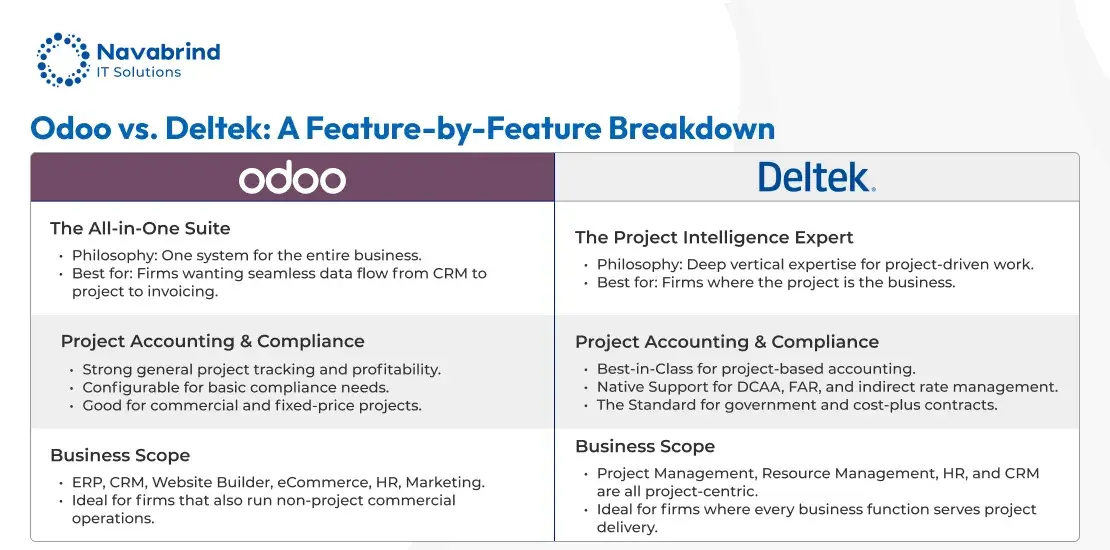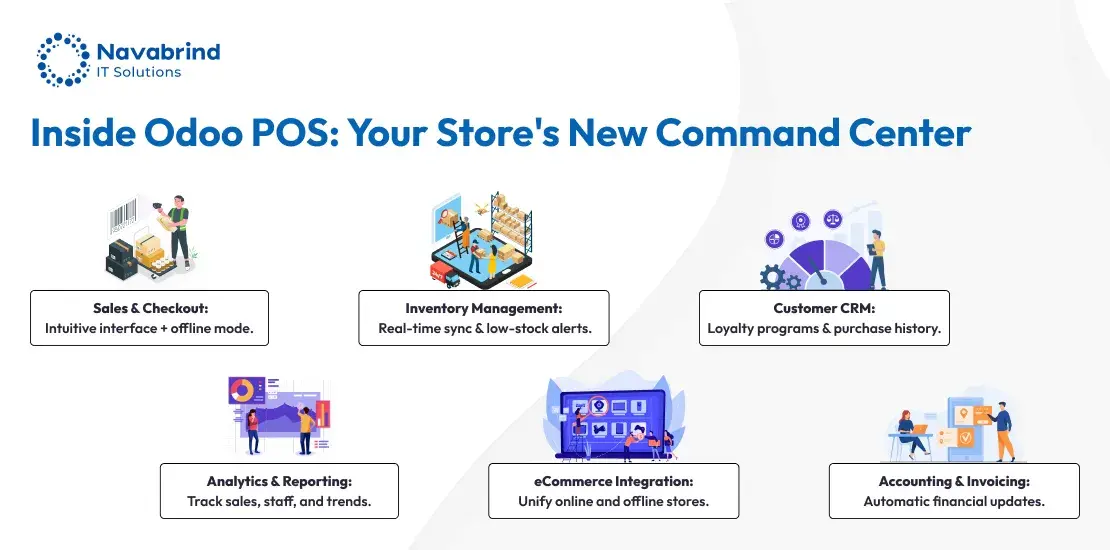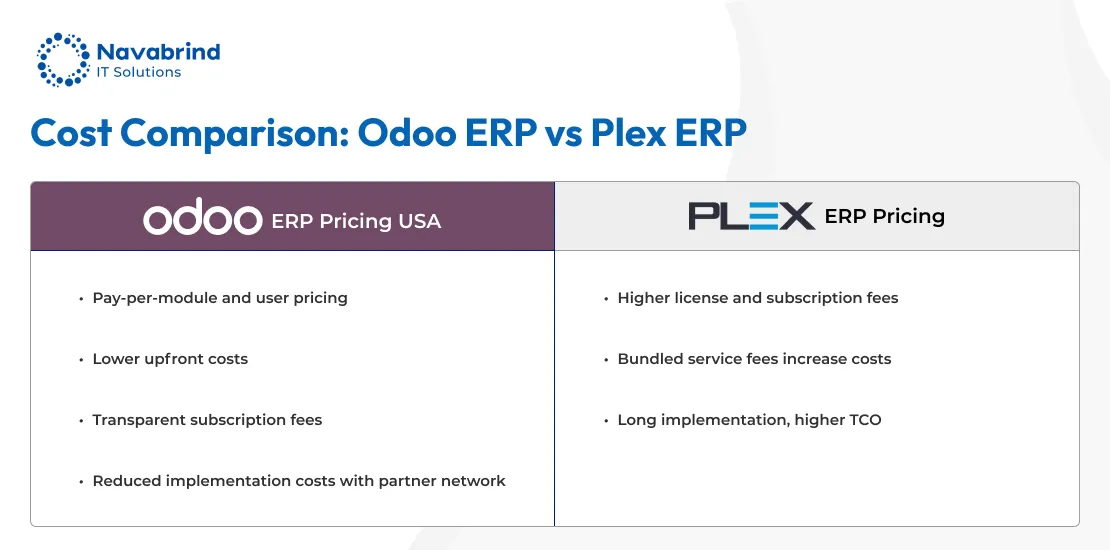Best Practices for Managing Large Product Catalogs with Navabrind PIM-Odoo Integration
- July 7, 2025
- Posted by: Tony
- Categories: Blog, PIM
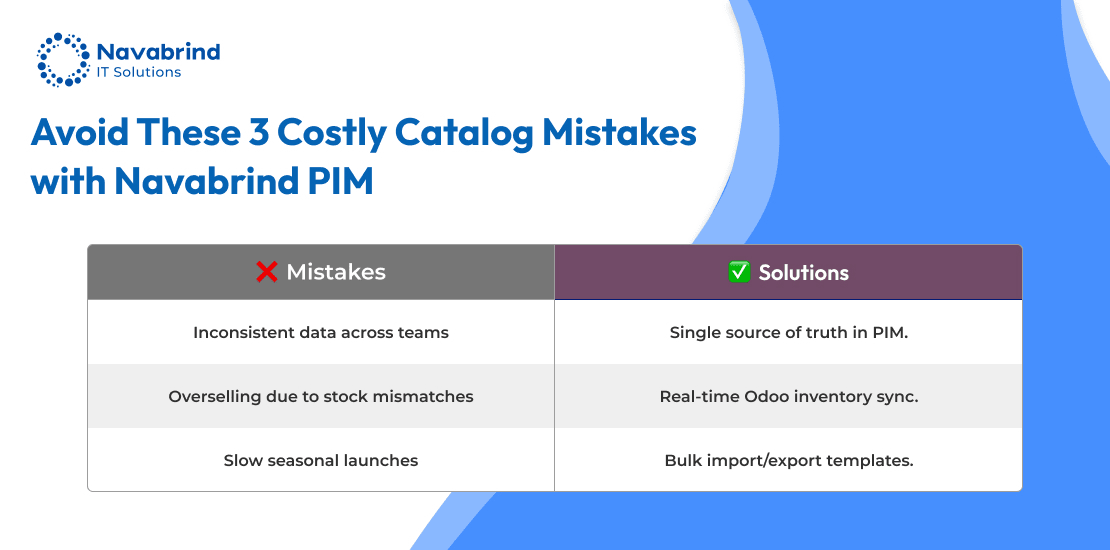
Your e-commerce business’s growth depends on how you handle your product catalog. Managing large catalogs in Odoo might feel daunting, yet it plays a vital role in customer relationships and business expansion.
A Product Information Management (PIM) system makes this complex process easier by organizing product data that can get overwhelming quickly. Navabrind PIM works great with Odoo’s complete business management solution and is an excellent PIM for multi-language product catalogs.
Why Large Catalogs Require Advanced Tools
Managing big product catalogs creates unique challenges when businesses grow their SKU counts. Research shows that companies with large catalogs face complex issues. Their forecast errors are four times higher at the SKU level compared to category level.
Complexities of handling product data for businesses with thousands of SKUs
Product data management gets trickier as SKU counts go up. Studies show that 70% of online buyers leave product pages that lack enough information. On top of that, businesses with big catalogs must handle multiple product variations, customization options, and mutually exclusive product combinations.
Challenges like inconsistent data, manual updates, and multi-channel synchronization
Things get more complex across sales channels. Data accuracy is the biggest hurdle, especially when you have manual updates across platforms that can get pricey. Businesses also struggle with:
- Stock levels not matching across channels
- Live pricing updates
- Product information staying consistent
- Content management in multiple languages
- Keeping up with regulations
Without the right tools, these challenges lead to missed sales and unhappy customers.
Introduction to Navabrind PIM-Odoo integration as a solution to streamline operations
Navabrind PIM integration with Odoo provides a detailed solution to these challenges. The system puts all product information in one place and automates key processes. This integration helps businesses keep their product data consistent across all channels accurately and in real time.
The Navabrind PIM-Odoo combination makes shared multi-channel synchronization possible. This reduces manual work and mistakes. Businesses expanding globally benefit from this integration because it simplifies product information management across different languages and regions.
Best Practices for Large Catalog Management with Navabrind Odoo-PIM Integration
Navabrind PIM-Odoo integration success depends on careful planning and proven methods. Research shows that companies using proper PIM solutions cut their catalog management costs by 30%.
Organize and Standardize Product Data — A consistent product data structure provides the foundation for better catalog management. Companies that centralize their data in one place see 40% fewer errors than those using scattered spreadsheets. Dynamic attributes in Odoo help categorize products and manage relationships between them.
Optimize Odoo Bulk Product Updates — Odoo’s features make bulk updates quick and simple. Studies reveal that automated PIM systems like the one offered by Navabrind IT Solutions reduce product update times by half. Automated workflows for repetitive tasks save time and maintain data accuracy across channels.
PIM for multi-language product catalogs — plays a vital role for companies expanding worldwide. Navabrind PIM-Odoo integration makes translation management simple through:
- Automated content synchronization
- Centralized translation management
- Live updates across channels
- Regional compliance tracking
Companies that use integrated PIM solutions see 35% better product information consistency. This improvement leads to higher customer satisfaction and brand loyalty in international markets.
PIM and Odoo integration builds a reliable foundation to manage complex product data. Companies that follow these practices launch products 40% faster and maintain better data accuracy across their sales channels.
a. Organize and Standardize Product Data
A strong foundation for product data management starts with proper organization and standardization. The well-laid-out PIM-Odoo integration works as a central hub for all product-related information. This eliminates scattered data across multiple platforms.
Tips for creating a consistent product data structure
The original implementation of standardized product information needs careful thought about data architecture. Your system should provide continuous connection for product categorization while data integrity remains intact across all channels. Odoo’s integration with a PIM lets businesses create customized attributes and categories that match their specific industry needs.
Data consistency improves through the platform’s automated validation tools that ensure accuracy at every touchpoint. Teams can manage product information through a single, unified interface. This standardization cuts manual effort by 72%.
Benefits of leveraging dynamic attributes in Odoo
Dynamic attributes in Odoo mark a major step forward in product data management. These attributes help businesses to:
- Create flexible product configurations without generating unnecessary variants
- Automate attribute updates across multiple channels
- Customize product information based on specific market requirements
- Handle complex product specifications efficiently
Businesses can manage extensive product catalogs through the platform’s dynamic attribute capability without affecting system performance. Without doubt, this feature becomes a great way to get results when handling products with multiple variations. It creates variants only when needed, which reduces database clutter and improves overall system efficiency.
b. Optimize Odoo Bulk Product Updates
Bulk updates are the life-blood of managing e-commerce catalogs today. Odoo’s multi-edit feature lets businesses change multiple product records at once. This cuts update time by 40%.
The quickest way to do bulk updates with Odoo’s features
The platform makes mass updates simple with its accessible interface. We selected multiple products and changed them all in one go. You can update these product details:
- Prices for product ranges
- Stock levels
- Category assignments
- Product attributes
Save time and stay accurate by automating repeated tasks
Of course, automation keeps your data precise. The system’s batch-processing handles complex updates without compromising data quality. The platform updates the database only when needed, which keeps everything running smoothly.
This automated approach brings great results. Companies that use these features see their profit margins jump by 75%. The system updates information on all channels at once, so product data stays consistent everywhere.
Smart validation during bulk operations keeps data accurate and reduces manual update errors. Companies using this systematic approach to mass updates have seen their conversion rates improve by 200%.
c. PIM for multi-language product catalogs for Global Markets
Research shows that 75% of online consumers want product information in their native language. Navabrind PIM integration with Odoo meets this significant need with detailed language management features.
Using PIM to manage translations for product catalogs
PIM makes the translation process simple by letting you choose which fields to translate and distribute content automatically. Businesses can manage translations of key product elements like descriptions, specifications, and marketing content. This approach cuts translation costs by 40% and keeps brand messaging consistent in different markets.
The platform combines automated and manual translation processes to get the best results. We focused on keeping the right brand voice while making sure technical details stay accurate. Businesses can now handle product information in up to 156 different languages.
How Odoo synchronizes multi-language product data across channels
Odoo’s synchronization system updates information live across channels and languages. The system keeps data accurate through:
- Automated field-level synchronization
- Market-specific content adaptation
- Live validation checks
- Centralized translation management
This integration lets businesses customize specific fields that need localization while keeping common attributes the same across markets. Companies can keep product information consistent and adapt to local market needs, which has reduced product return rates by 35%.
The system’s smart workflow management helps internal teams work with external translators to create accurate translations in every channel. All the same, the platform keeps data reliable by updating changes automatically to prevent differences between language versions.
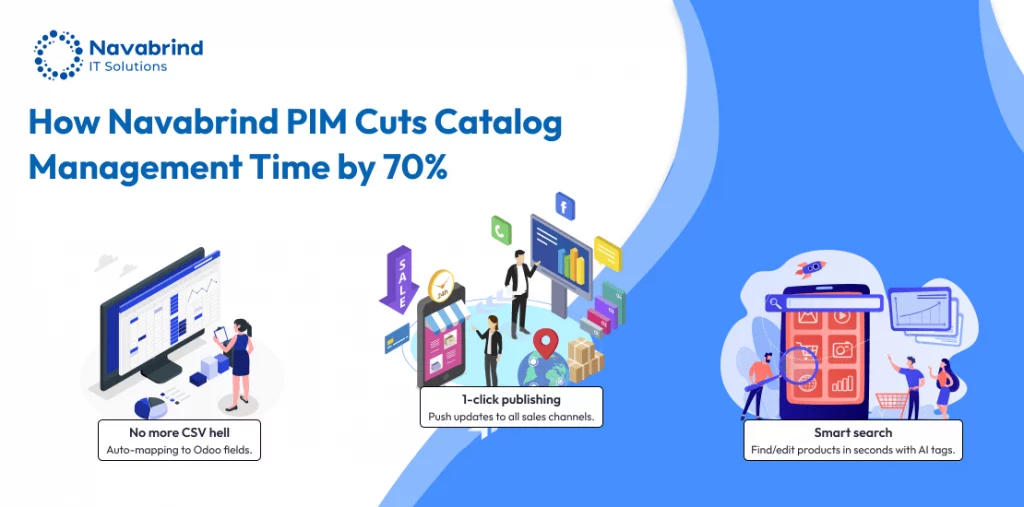
How PIM and Odoo Handle Complex Product Data Efficiently
PIM and Odoo integration transforms how businesses handle complex product information. This unified system makes up-to-the-minute data management possible in multiple channels through advanced synchronization.
Up-to-the-minute synchronization between PIM and Odoo for uninterrupted data management
The system’s declarative strategy will give a universal compatibility with data types of all kinds and focuses on data integrity. Product information, inventory levels, and pricing details sync automatically across connected platforms. Businesses see a 260% growth in sales because of better data accuracy and consistency.
Handling variations like size, color, and material with dynamic attributes
Dynamic attribute management marks a major improvement in product variant control. The system’s three distinct variant creation modes include:
- Instantly: Creates variants directly from product configuration
- Dynamically: Generates variants only upon first sale
- Never: Manages variations without creating separate product entries
This flexible attribute management has cut operational effort by 72%. Businesses can now handle complex product configurations quickly.
Scalability for managing ever-growing product catalogs
The platform’s scalability helps expand product lines without affecting performance. Businesses report a 75% increase in profit margins soon after implementation through better catalog management. The system’s unique technology syncs large data volumes instantly, even in complex environments.
The platform adjusts data flows smoothly and works especially when you have extensive product catalogs in multiple stores. This integrated approach boosts conversion rates by 200%, showing its value in managing growing product portfolios.
Benefits of Navabrind PIM-Odoo Integration for Product Catalog Management
Businesses managing large product catalogs see significant advantages when they integrate PIM with Odoo. Research shows that companies using this integration achieve a 260% growth in sales.
Centralized data management for accuracy and consistency
A unified system maintains data accuracy across channels. Companies report a 72% reduction in operational effort with centralized product information management. The integration removes data silos and keeps product specifications, pricing, and inventory levels in sync across platforms.
Faster time-to-market with streamlined processes
Product launch capabilities improve significantly with optimized workflows. Companies achieve:
- 75% increase in profit margins through better catalog management
- 200% improvement in conversion rates with faster product updates
- Less time spent on product data entry and validation
Improved customer experience through enriched and up-to-date product information
Up-to-date product information boosts customer satisfaction. Studies show that 61% of organizations consider improved customer experience as the key benefit of PIM implementation. Rich product content in the system reduces shopping cart abandonment rates effectively.
The benefits go beyond operational improvements. Accurate product information builds customer trust, which leads to fewer returns and loyal customers. Better-linked product data creates more opportunities for up-selling and cross-selling.
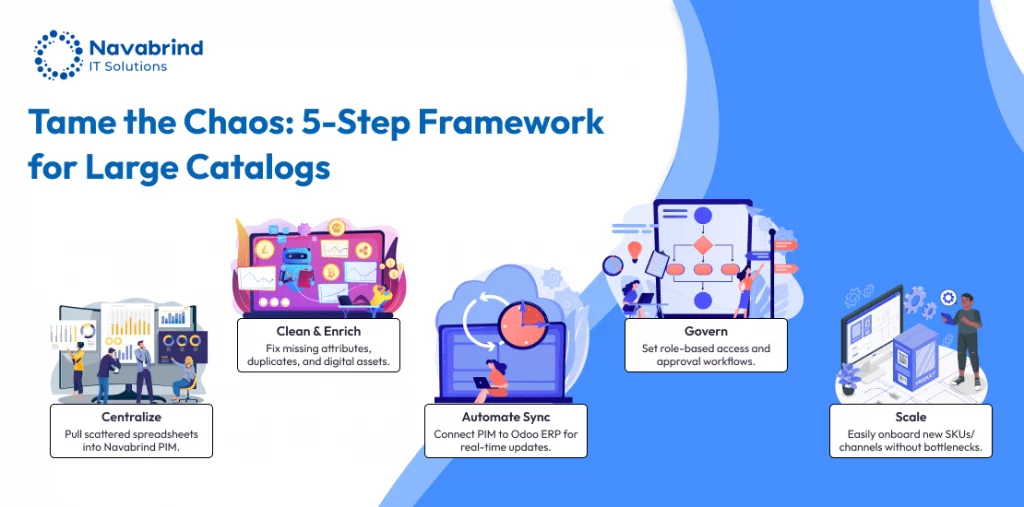
Implementation Tips for PIM-Odoo Integration
Picking and setting up the right PIM solution needs you to think about several key factors. A full picture will help you combine smoothly with your Odoo system.
Finding a PIM system that works naturally with Odoo
You need to focus on these points to evaluate PIM systems for Odoo integration:
- Data synchronization capabilities
- Scalability potential
- Integration complexity
- Support for custom data structures
- Economical solutions
Step-by-step guidance for setting up the integration
The integration starts with detailed planning and analysis. You need to spot critical data, workflows, and functions that need migration or customization. The setup involves configuring data feeds and creating clear communication channels between systems.
Best practices to keep data accurate during migration
Data accuracy is the life-blood of successful migration. Setting up proper validation mechanisms and data cleaning protocols will give a solid foundation for information integrity. The process should include:
- Creating detailed data mapping documentation
- Setting clear validation rules
- Running automated data quality checks
- Keeping backup systems throughout migration
Your business can choose a phased implementation approach that gives better control and reduces risks. This method shows a 75% reduction in migration-related issues.
The integration’s success depends on thorough testing and validation procedures. Regular checks and adjustments of data feeds help maintain peak performance and accuracy in system synchronization.
Ready to manage your large product catalog with Navabrind PIM- Odoo Integration?
Navabrind PIM-Odoo integration is a great way for growing businesses to manage large product catalogs. This powerful combination keeps data accurate across all channels while making operations smoother. Businesses using these methods have seen amazing results – 260% growth in sales and 75% higher profit margins.
Three key aspects make Navabrind PIM-Odoo integration work well. You need standardized data organization, quick bulk update processes, and complete multi-language support. These elements create a strong base to handle complex product information.
Your implementation strategy can make or break success. The system works best when you plan carefully, test thoroughly, and monitor regularly. Setting up takes work initially, but the rewards are worth it. You’ll spend less on operations, launch products faster, and make customers happier. Navabrind PIM-Odoo integration does more than solve technical challenges. It revolutionizes product information management and helps businesses grow into new markets. Your product data stays consistent and high-quality across every channel.
Frequently Asked Questions
1. How does Navabrind PIM-Odoo integration help manage large product catalogs?
Managing large product catalogs can be overwhelming without the right tools, but Navabrind PIM-Odoo integration simplifies this process by combining the best of both systems:
- Centralized Data Management: PIM provides a centralized repository for storing all product information, while Odoo ERP ensures that the data is seamlessly shared across various business operations like inventory, sales, and marketing.
- Efficient Large Catalog Management with Odoo: Odoo’s capabilities include managing thousands of SKUs, variations, and hierarchical categories, allowing businesses to handle complex product portfolios with ease.
- Dynamic Attributes Management with Odoo: PIM-Odoo supports the creation and management of dynamic product attributes like size, color, material, or region-specific specifications, making it ideal for businesses with diverse product offerings.
- Odoo Bulk Product Updates: When changes like price adjustments or product descriptions need to be applied across multiple SKUs, PIM-Odoo enables bulk updates, saving significant time and reducing manual errors.
This integration ensures that businesses can manage large catalogs effectively while maintaining accuracy and efficiency.
2. What are the key benefits of using Navabrind PIM-Odoo for large catalogs?
Navabrind PIM-Odoo integration offers numerous benefits for businesses managing large product catalogs, including:
- Simplified Data Entry and Updates: With PIM acting as the central hub, product data can be entered once and automatically distributed to Odoo and other connected systems, reducing redundant work.
- Scalability for Large Catalogs: PIM-Odoo is built to handle extensive catalogs with thousands of SKUs, variations, and custom attributes, ensuring the system grows with your business.
- Support for Multi-Language Product Catalogs: PIM-Odoo is ideal for businesses targeting global markets, as it supports multi-language descriptions, localized pricing, and region-specific marketing materials.
- How PIM and Odoo Handle Complex Product Data Efficiently: The integration ensures that even complex product data—such as bundled products, variants, and technical specifications—is managed seamlessly across platforms.
- Improved Productivity: Automation features like bulk updates, real-time data synchronization, and validation workflows reduce manual effort, enabling teams to focus on strategic tasks.
These benefits make Navabrind PIM-Odoo an indispensable solution for businesses with large and growing product catalogs.
3. How can product categorization be optimized with Navabrind PIM-Odoo integration?
Effective product categorization is crucial for improving customer experience and operational efficiency. Navabrind PIM-Odoo integration excels at optimizing categorization in the following ways:
- Customizable Category Hierarchies: Navabrind PIM allows businesses to create detailed and flexible category structures that align with their product taxonomy, while Odoo ensures these categories are consistently applied across sales channels.
- Dynamic Attributes Management with Odoo: Businesses can assign dynamic attributes to products and categories, enabling better filtering and navigation on eCommerce websites and other platforms.
- Automated Category Updates: Changes to categories or product assignments in PIM are automatically reflected in Odoo, ensuring consistency across channels.
- Enhanced Searchability and SEO: Navabrind PIM-Odoo ensures that products are categorized effectively, improving search engine rankings and making it easier for customers to find what they’re looking for.
By leveraging Navabrind PIM-Odoo, businesses can create a robust product categorization strategy that enhances both internal operations and customer experiences.
4. What are the best practices for maintaining data consistency in large catalogs using Navabrind PIM-Odoo?
Data consistency is critical for ensuring accurate product information across all channels. Here are some best practices for maintaining it with Navabrind PIM-Odoo:
- Centralized Data Hub: Use PIM as the single source of truth for all product information, ensuring that updates are made once and distributed automatically to Odoo and other systems.
- Standardized Data Formats: Define consistent formats for attributes like dimensions, weights, and descriptions to avoid discrepancies across channels.
- Odoo Bulk Product Updates: Leverage Odoo’s bulk update functionality to apply changes to large catalogs efficiently, reducing the risk of errors.
- Validation and Approval Workflows: Implement workflows in PIM to ensure that only accurate, complete, and approved data is synchronized with Odoo.
- Real-Time Synchronization: Ensure that Navabrind PIM-Odoo integration supports real-time updates so that all platforms reflect the latest information.
Adhering to these practices ensures that businesses can maintain high data quality while managing large and complex product catalogs.
5. How does Navabrind PIM-Odoo integration support multi-channel e-commerce with large catalogs?
Navabrind PIM-Odoo integration is specifically designed to support multi-channel e-commerce by streamlining the management of large product catalogs across diverse platforms.
- Centralized Catalog Management: With Navabrind PIM, businesses can manage all product data in one place, while Odoo ensures seamless integration with multiple sales channels, such as eCommerce websites, marketplaces, and social media platforms.
- Efficient Large Catalog Management with Odoo: Odoo’s multi-channel capabilities ensure that extensive product catalogs are organized and synced accurately across all platforms.
- Support for Multi-Language Product Catalogs: Navabrind PIM-Odoo enables businesses to cater to global audiences by managing multi-language content and regional variations efficiently.
- Consistency Across Channels: Navabrind PIM-Odoo ensures that product data, pricing, and availability are consistent across all channels, strengthening the brand image and enhancing customer trust.
- Improved Customer Experience: By ensuring accurate and uniform product data across all touchpoints, businesses can provide a seamless shopping experience, boosting customer satisfaction and loyalty.
This integration empowers businesses to scale their multi-channel strategies without compromising on operational efficiency or data accuracy.
6. What challenges can be resolved with Navabrind PIM-Odoo integration?
Managing large product catalogs comes with several challenges, but PIM-Odoo integration offers solutions to address these effectively:
- Data Inconsistencies: Navabrind PIM-Odoo resolves discrepancies in product data by centralizing information and automating updates across all platforms.
- Complex Product Data: The integration handles complex data like bundled products, multiple variants, and region-specific attributes with ease.
- Time-Consuming Manual Updates: Odoo bulk product updates allow businesses to apply changes across large catalogs quickly and accurately.
- Scaling for Growth: PIM-Odoo is designed to support growing businesses, enabling seamless management of expanding product catalogs without overwhelming the system.
- Multi-Channel Challenges: By synchronizing data across multiple channels, Navabrind PIM-Odoo ensures that all platforms display accurate and up-to-date product information.
- Global Expansion Needs: With support for multi-language product catalogs and localized content, PIM-Odoo simplifies the process of entering new markets.
By addressing these challenges, Navabrind PIM-Odoo integration becomes an invaluable tool for businesses managing diverse and extensive product catalogs.
Schedule a conversation with us now!
Related Articles
-
Post
Odoo ERP vs. Deltek – Which ERP Fits Your Architecture, Engineering, Construction, or Consulting Firm?
Odoo ERP vs. Deltek – Which ERP Fits Your Architecture, Engineering, Construction, or Consulting Firm? December 11, 2025 Posted by: Tony Category: Odoo ERP vs Deltek No Comments Why Architecture, Engineering, Construction (AEC), and Consulting Industries Need ERP Systems ERP systems have become indispensable tools for Architecture, Engineering, Construction, and Consulting firms, which handle multi-faceted -
Post
Streamline Your Store: A Deep Dive into the Odoo Point of Sale System
Streamline Your Store: A Deep Dive into the Odoo Point of Sale System December 5, 2025 Posted by: Tony Category: Uncategorized No Comments The Heart of the Modern Retail Experience Picture this: a customer walks into your store, finds what she is looking for and is ready to buy. Your online store just received five -
Post
Odoo ERP vs Plex ERP: Which Open Source Powerhouse Will Transform US Manufacturing
Odoo ERP vs Plex ERP: Which Open Source Powerhouse Will Transform US Manufacturing November 27, 2025 Posted by: Tony Category: Uncategorized No Comments As demand for cost-effective ERP solutions in the USA increases, businesses are turning to the best open source ERP software, Odoo ERP USA, for a flexible, scalable, and affordable approach to digital
How can we help you?
Get in touch with a solutions consultant that can share best practices and help solve specific challenges.







